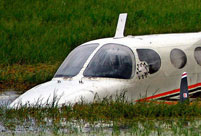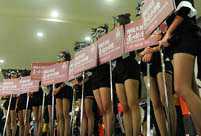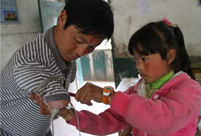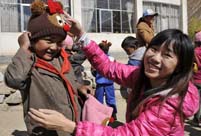Citizens' right to employment is protected.
Since the democratic reform in Tibet in 1959, all trades in Tibet have thrived, areas of employment have expanded and the requirement for employees' knowledge and skills raised. The government vigorously encourages farmers and herdsmen to seek employment locally by promoting free vocational training, building labor service brands, and improving the mechanism for organized transfer employment and providing better employment environment for migrant workers. The government helps "zero-employment" families, the disabled and other groups with employment difficulties to find jobs by increasing public welfare positions, "enacting policies and providing jobs, skill training, employment services" and other employment assistance. In recent years the government has provided public welfare positions for 19,867 people with employment difficulties, thereby eliminating the number of "zero-employment" families. The government has actively built a two-way selection platform for urban and rural employers and workers. In 2012 new jobs in other fields were found for 450,000 farmers and herdsmen. At the same time 14,153 higher-education graduates were employed, with an employment rate of 98.36 percent. To protect the lawful rights and interests of the workers, the government has set a standard for minimum wages, promoted the adoption of labor contract and collective bargaining, enhanced labor supervision, mediation and arbitration, and improved the mechanism of preventing and handling labor-management dispute cases. In 2012 Tibet' s newly increased urban employment totaled 25,000, and the registered urban unemployment rate was below 2.6 percent.
The people's health has increasingly improved.
Before the peaceful liberation of Tibet, only Lhasa and Shigatse had government-run Tibetan medical institutions, private clinics and Tibetan doctors, which were small in both number and operating size. Now Tibet has a public medical and health service system combining Tibetan medicine, Western medicine and traditional Chinese medicine that covers all urban and rural areas of the autonomous region with Lhasa as the center, thereby realizing the objective of "one clinic for one village." In 2012 Tibet had 6,660 medical and health institutions, 8,352 hospital beds and 21,558 health workers (including 9,336 health technicians). The medical institutions provided treatment on 10.12 million occasions and accommodated patients in hospitals on 145,500 occasions. Free medical services are now available to all the farmers and herdsmen in the autonomous region. The subsidy for these medical services was raised from 5.5 yuan annually per person in 1993 to 300 yuan in 2012. The autonomous regional government allocated a special fund of 23 million yuan to set up a major disease supplementary health insurance for farmers and herdsmen. Tibet was the first in China to provide free physical examinations for urban and rural residents, and the subsidy has been raised to 300 yuan annually per capita. In 2012 Tibet provided free medical treatment to 1,032 children with congenital heart defects (CHD). Tibet has set up 81 disease prevention and control institutions; promoted an immunization program throughout the autonomous region; improved the epidemic disease reporting and monitoring system; basically contained plague, tuberculosis (TB), leprosy, Kashin-Beck disease (KBD) and iodine deficiency disorders (IDD); reduced the incidence of measles, diphtheria, pertussis, tetanus, poliomyelitis and other infectious diseases by a large margin; and basically eliminated IDD, with an iodized salt coverage rate of 96.59 percent. In 2012 Tibet implemented a fitness program for farmers and herdsmen in 1,000 administrative villages; enhanced the construction of urban physical fitness zones and gymnasiums; ensured that agricultural and pastoral areas have fitness sites and equipment; promoted a scientific fitness program; and enhanced the building of community-level sports organizations, community sports clubs and nationwide fitness centers to improve the people' s health and quality of life. Tibet has been implementing a flexible birth-control policy, which exempts the farmers and herdsmen, who account for over 80 percent of Tibet' s total population, from the limit set on the number of children one couple could have. The government encourages late marriage and postponed childbearing, healthy pregnancy and scientific nurture, and healthy and civilized marriage lives.
Before the peaceful liberation, Tibet's population remained stagnant for a long period of time because of economic backwardness, low survival rate of newborns, poor medical conditions and a large proportion of monks and nuns in the total population. But since the peaceful liberation, Tibet' s population increased from 1.1409 million in 1951 to 3.002 million in 2010, of which 2.716 million were Tibetans, accounting for more than 90 percent of the total; over 40,000 were from other ethnic-minority groups, accounting for 1.3 percent; and 245,000 were Han people, accounting for 8 percent. In 2012 Tibet' s total population reached 3.08 million. The average life expectancy there has increased from 35.5 years in 1951 to 68.17 years now; the death rates of infants and women in childbirth have dropped greatly and the people' s health has been remarkably improved.
Social security system increasingly improved.
In recent years Tibet's social security system has been increasingly improved, so that the sick can seek medical treatment, the elderly are cared for and the financially straitened can receive aid. By the end of 2012 Tibet had established a social security system consisting of basic old-age insurance, basic health insurance, unemployment insurance, work-related injury insurance and maternity insurance, and covering all urban and rural residents, with an insured population of 2.397 million. In 2012 Tibet covered all types of social insurance to the tune of 2.38 billion yuan. The basic living allowance coverage keeps expanding in urban and rural Tibet, and the amount of allowance granted has been raised several times. In 2012, 48,047 urban residents and 329,000 rural residents received basic living allowances from the government, with 400 yuan per person per month in cities and 1,600 yuan per person per year in the countryside. The yearly payment to those who enjoy the "five guarantees" (for food, clothing, medical care, housing and funeral expenses) has been raised significantly to 2,600 yuan per person per year in 2013. People with economic difficulties in urban and rural areas received medical aid on nearly 120,000 occasions, with total funds amounting to 205.75 million yuan. A total of 6,925 urban and rural households with economic difficulties received temporary relief funds totaling 7.762 million yuan. A total of 6,432 students with financial hardships were provided with 16.769 million yuan in assistance. By August 2012 a total of 394,636 urban and rural residents entitled to basic living allowance, the "five guarantees" and special social care received temporary price subsidies totaling 126.069 million yuan. Under the special care of the government, all the monks and nuns in Tibet have been included in the social security system and covered by health insurance, old-age insurance and basic living allowance. Monks and nuns above the age of 60 receive a 120 yuan monthly pension; nuns above the age of 60 and monks above the age of 65 enjoy permanent basic health insurance.
 |  |
 No news of survivors in Lao Airlines crash
No news of survivors in Lao Airlines crash Five fighters in flight training
Five fighters in flight training London mayor hails free trade, subway system on China tour
London mayor hails free trade, subway system on China tour Different eye catching shows at housing fairs in China
Different eye catching shows at housing fairs in China Chalk it up to great courage
Chalk it up to great courage Tibetan girl helps mobilize volunteers onlin
Tibetan girl helps mobilize volunteers onlin Lingerie show dazzles Wuhan Motor Show 2013
Lingerie show dazzles Wuhan Motor Show 2013  Chinese screen goddesses from Beijing Film Academy
Chinese screen goddesses from Beijing Film Academy  Weekly Sports Photos
Weekly Sports Photos Bayi Parachute Team of PLA Air Force
Bayi Parachute Team of PLA Air Force World has never been dark-- a blind kid’s life in Tibet
World has never been dark-- a blind kid’s life in Tibet Change to law may make it easier to sue polluters
Change to law may make it easier to sue polluters UNESCO world heritage site: Montale Tower
UNESCO world heritage site: Montale Tower U.S. Senate leader announces bipartisan deal
U.S. Senate leader announces bipartisan deal Fiber-optic wedding dress show shinning in Suzhou
Fiber-optic wedding dress show shinning in Suzhou Day|Week|Month